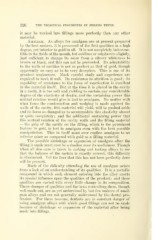Page 490 - My FlipBook
P. 490
226 THE TECHNICAL PKOCEDUBES IN FILLING TEETH.
it may be worked into fillings more perfectly than any other
material.
Amalgam. As alloys for amalgam are at present prepared
by the best makers, it is possessed of the first qualities in a high
degree, yet inferior to gold in all. It is not completely indestruc-
tible in the fluids of the mouth, but oxidizes or sulphurets slightly,
just sufficient to change its color from a silvery whiteness to
brown or black, and this can not be prevented. Its adaptability
to the walls of cavities is not so perfect as that of gold, though
apparently so easy as to be very deceptive. This is one of its
greatest weaknesses. Much careful study and experience are
required to work it well. Its resistance to attrition is good ; its
capability of resistance to the force of mastication is excellent
in the material itself. But at the time it is placed in the cavity
in a tooth, it is too soft and yielding to sustain any considerable
degree of the elasticity of dentin, and the sustaining power this
mutual relation would give is lost to amalgam. No matter with
what force the condensation and wedging is made against the
walls of the cavity, this material will yield, will be pushed aside
and its form so changed as to accommodate this elasticity almost
or quite comi^letely; and the additional sustaining power that
this mutual relation of the cavity walls and the filling material
— the grip of the cavity on the filling, which is the prominent
feature in gold, is lost to amalgam even with the best possible
manipulation. This in itself must ever confine amalgam to an
inferior place as compared with gold as a filling material.
Tlie possible shrinkage or expansion of amalgam after the
filling is made must ever be a shadow over its usefulness. Though
when all due care is taken in making and testing alloys to see
that the balance of the metals is exactly correct, this difficulty
is eliminated. Yet the fear that this has not been perfectly done
will be present.
Much of the difficulty attending the use of amalgam arises
from a lack of an understanding of its qualities. It is a metallic
compound in which each element entering into the alloy exerts
its special influence upon the qualities of the product ; and these
qualities are varied with every little change in its composition.
These changes of qualities and the laws controlling thorn, though
well made out, are as yet understood by but few makers of amal-
gam alloys and are not generally understood by the dental pro-
fession. For these reasons, dentists are in constant danger of
using amalgam alloys with which good fillings can not be made
because of shrinkage or expansion of the material after being
made into fillings.


